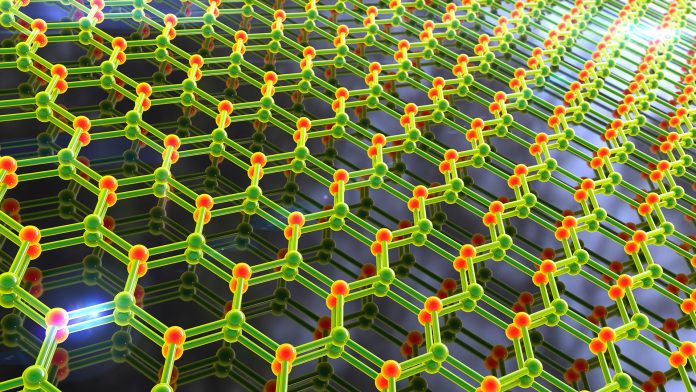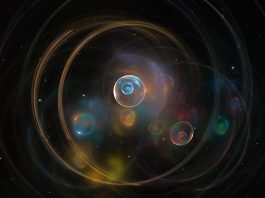For many years, the LMI laboratory in Lyon has been developing the tailored synthesis of boron nitride by pyrolysis of preceramic polymers.
As technology advances, scientists are searching for new materials to meet the demands of our ever-changing world. One of the most promising categories is two-dimensional (2D) materials, which are only a few atoms thick. Among these, boron nitride (BN), an inorganic compound made of equal numbers of boron and nitrogen atoms, is currently the subject of much research and development. BN is a unique material whose properties can vary according to the arrangement of the B and N atoms.
The various forms of BN are isostructural to the carbon materials. The cubic form of BN (c-BN) has a crystalline arrangement similar to that of the diamond, while the hexagonal structure of BN (h-BN), which is the most stable crystalline form, resembles graphite. Because of this isostructural feature, h-BN is also called ‘white graphite’. It is a layered material where, in each layer, the nitrogen and boron atoms are strongly linked by covalent bonds in a honeycomb lattice. The layers are held together by weak interactions, the van der Waals forces. The interlayer arrangement of these sheets, however, differs from the model observed for graphite, as the atoms are staggered, which leads to several polytypes, the most famous, after h-BN, being the rhombohedral (r-BN). In h-BN, the B atoms are on top of the N atoms. This structure conducts to an extremely stable ceramic material with high thermal conductivity which is also an excellent electrical insulator, with an ultra-wide band gap of about 6 eV. In recent years, with the rise of graphene1 and the subsequent progress of research on single- and multi-layer graphitic nanosheets, a growing interest has developed in 2D h-BN.
The importance of efficient and cost-effective synthesis methods of h-BN sheets
With the same honeycomb structure and lattice parameters remarkably close to those of graphite,2 it is often considered as an ideal insulating substrate for graphene and as the best barrier material in vdW heterostructures.3 All of these properties make h-BN ideal for use in electronics, photonics and optoelectronics, where it can be used to create a variety of devices, including transistors, photodetectors and sensors. As a result, h-BN has become a key material in 2D materials research and a promising candidate for future technological innovations.4
For all these reasons, it has become increasingly important to develop efficient and cost-effective methods for the synthesis of h-BN sheets. H-BN is not found in nature because its synthesis is a difficult process due to the high reactivity of its components that must be combined in specific ratios at extreme temperatures and pressures, which can be challenging to achieve. BN is thus produced only synthetically, mainly from pure boron, boric acid (H3BO3)5 or boron trioxide (B2O3).
In recent years, other various methods have been developed to synthesise 2D h-BN nanostructures. Two main approaches can be distinguished, the bottom-up approach and the top-down approach. The bottom-up approach involves growing or assembling BN nanostructures from small building blocks. These building blocks can be either inorganic or organic molecules. For instance, h-BN nanosheets can be synthesised from borazine (B3N3H6) molecules using chemical vapour deposition (CVD), a chemical process in which a vapour phase is used to deposit a thin film of material onto a substrate. The borazine is typically fed into a high-temperature reactor where it is decomposed to form h-BN layers on the substrate. The CVD-deposited h-BN films are mainly polycrystalline with a grain size generally of several tens of micrometres with a triangular shape. Wafer-scale deposits can be obtained but it is often necessary to transfer them to the target substrate for industrial process integration. The top-down method, on the other hand, involves starting from a pre-existing bulk h-BN material and then gradually reducing its size until the desired thickness is obtained. This approach is typically used to produce h-BN nanosheets using either chemical or mechanical exfoliation to break the Van der Waals forces between the hexagonal layers and physically separate the resulting 2D sheets of h-BN from the bulk material. Even if the size of the exfoliated structures is usually reduced and their yield can be small, the original quality of the starting bulk material is retained after exfoliation. Therefore, it is important to have large (on the order of a few millimetres) single-crystal h-BN sources as starting materials available for the exfoliation of 2D h-BN sheets that can be further integrated into commercial devices. However, achieving crystals up to the millimetre scale remains a challenge.
Developing the synthesis of h-BN in different forms
At the Laboratoire des Multimatériaux et Interfaces (LMI) of the University of Lyon, France, we have been developing, for many years, the synthesis of h-BN in different forms (fibres, thin films, nanotubes, meso or microporous membranes) for tribological, thermostructural, or energetic applications. The access to these specific forms is made possible by the synthesis route used, the pyrolysis of pre-ceramic polymers (PDCs), which consists in synthesising a molecular precursor and polymerising it into an inorganic pre-ceramic polymer that can be shaped before ceramisation.
For the development of h-BN, the molecular precursor we use is borazine because it already shares its hexagonal structure with the target h-BN. Since liquid borazine is highly volatile at room temperature, for crystal growth, its polymeric form, polyborazylene, is preferred and is obtained as a white powder after a polymerisation process. The formation of h-BN by polymeric precursors is greatly enhanced by using an alkaline-based solvent such as Li3N, promoting the mobility of the species once melted.6,7 Thus, the PDCs’ route allows the elaboration of h-BN with tailored textural and structural properties.

Over the past decade, with the integration of LMI into the framework of the Graphene Flagship, an EU-funded project that seeks to explore the potential of graphene-based materials, our research efforts have focused on improving the PDCs’ pathway for the fabrication of h-BN nanomaterials. In particular, by coupling PDCs with different sintering processes, such as spark plasma sintering (SPS), pressure controlled furnace (PCF), or gas pressure sintering (GPS) starting from the same pre-ceramic polymer, the crystal size can be increased from a few microns to a few millimetres.8–11 Furthermore, by combining PDCs with atomic layer deposition (ALD), functional BN nano-/hetero-structures have been successfully synthesised from highly structured sensitive templates, making this ALD process a promising alternative for the fabrication of functional BN nanostructures.12–15 It has been shown that the crystallinity level of the deposited BN material is strongly dependent on the crystallinity level of the substrate.
Finally, these h-BN materials, produced by the PDCs’ chemical process, have demonstrated their interest in both electronic and optical applications. Indeed, it has been possible to realise, as a proof of concept, the first successful application of van der Waals heterostructures made of MoSe2 and WSe2 monolayers encapsulated in h-BN sheets realised at LMI.16 Very encouraging results have also been obtained on metal-hBN-metal capacitor devices using h-BN from LMI.17
This demonstrates that the combination of the PDCs’ route with shaping techniques provides an ideal platform for tuning the structure, crystallinity and morphology of the final h-BN materials depending on the chosen synthesis conditions, and the intended applications.
References
- Novoselov, K. S. et al. Electric Field Effect in Atomically Thin Carbon Films. Science 306, 666–669 (2004)
- Hod, O. Graphite and Hexagonal Boron-Nitride have the Same Interlayer Distance. Why? J. Chem. Theory Comput. 8, 1360–1369 (2012)
- Golberg, D. et al. Boron Nitride Nanotubes and Nanosheets. ACS Nano 4, 2979–2993 (2010)
- Roy, S. et al. Structure, Properties and Applications of Two-Dimensional Hexagonal Boron Nitride. Advanced Materials 33, 2101589 (2021)
- Balmain, W. H. XLVI. Observations on the formation of compounds of boron and silicon with nitrogen and certain metals. The London, Edinburgh, and Dublin Philosophical Magazine and Journal of Science 21, 270–277 (1842)
- Yuan, S., Toury, B., Journet, C. & Brioude, A. Synthesis of hexagonal boron nitride graphene-like few layers. Nanoscale 6, 7838–7841 (2014)
- Yuan, S. et al. Low-Temperature Synthesis of Highly Crystallized Hexagonal Boron Nitride Sheets with Li3N as Additive Agent. European Journal of Inorganic Chemistry 2014, 5507–5513 (2014)
- Yuan, S. et al. How to Increase the h-BN Crystallinity of Microfilms and Self-Standing Nanosheets: A Review of the Different Strategies Using the PDCs Route. Crystals 6, 55 (2016)
- Yuan, S. et al. Pure & crystallized 2D Boron Nitride sheets synthesized via a novel process coupling both PDCs and SPS methods. Scientific Reports 6, 20388 (2016)
- Li, Y. et al. Advanced synthesis of highly crystallized hexagonal boron nitride by coupling polymer-derived ceramics and spark plasma sintering processes—influence of the crystallization promoter and sintering temperature. Nanotechnology 30, 035604 (2018)
- Li, Y., Garnier, V., Steyer, P., Journet, C. & Toury, B. Millimeter-Scale Hexagonal Boron Nitride Single Crystals for Nanosheet Generation. ACS Appl. Nano Mater. 3, 1508–1515 (2020).
- Hao, W., Marichy, C. & Brioude, A. Promising properties of ALD boron nitride nanotube mats for water purification. Environ. Sci.: Nano 4, 2311–2320 (2017)
- Marichy, C. et al. Fabrication of BN membranes containing high density of cylindrical pores using an elegant approach. RSC Adv. 7, 20709–20715 (2017)
- Hao, W., Marichy, C. & Brioude, A. Promising properties of ALD boron nitride nanotube mats for water purification. Environ. Sci.: Nano 4, 2311–2320 (2017)
- Matsoso, B. et al. Synthesis of hexagonal boron nitride 2D layers using polymer derived ceramics route and derivatives. J. Phys. Mater. 3, 034002 (2020)
- Maestre, C. et al. From the synthesis of hBN crystals to their use as nanosheets in van der Waals heterostructures. 2D Mater. 9, 035008 (2022)
- Pierret, A. et al. Dielectric permittivity, conductivity and breakdown field of hexagonal boron nitride. Mater. Res. Express 9, 065901 (2022)
Please note, this article will also appear in the thirteenth edition of our quarterly publication.









